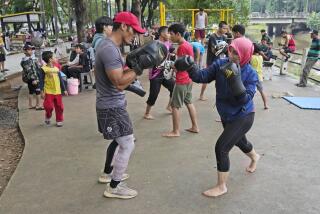‘Kill Bill’ without all the gore
As a huge fan of Uma Thurman’s deadly maneuvers in the “Kill Bill” films, I was eager to try my hand at samurai sword fighting. Let’s face it, there’s nothing quite as hot as a woman who knows how to wield a sword.
But judging from my first attempt, I don’t think Quentin Tarantino will be calling. Had it been a real sword, I would have lost a few fingers.
“Uh, you really don’t want to put your hand on the blade there,” said Jinenkan Fitness & Martial Arts sensei Peter Steeves, correcting my form in what I thought was a fierce pose with the wooden training sword.
Lesson No. 1: Grab the sword by the handle, not the blade. Check.
My friend Victor, who had joined me for the lesson, snickered at my gaffe, but Steeves told him not to be too smug. “We’ll get you on something yet,” he said.
Later in the class, Victor swung his sword with the blade facing backward.
“See, I told you,” Steeves said.
Jinenkan, which means “hall of nature,” is a martial art incorporating ancient sword-fighting techniques of the samurai. Steeves, a fourth-degree black belt who studied in Japan for five years, now teaches in his Los Angeles studio.
Since the release of such films as “Kill Bill” and “The Last Samurai,” the popularity of Japanese sword fighting has surged. “I remember back in the ‘80s everybody wanted to learn about the ninja because of those movies. Now, it’s the samurai,” said Steeves, who opened his studio three years ago.
There are many schools of Japanese sword fighting, but Steeves’ class is one of only about dozen in the nation in which samurai wannabes can learn jinenkan specifically. The class combines drills with wooden swords and partner sparring with foam swords. If you’ve ever wanted a socially acceptable reason to bash someone over the head a la whack-a-mole, here’s your chance.
“I wanted to do it since I was a kid watching samurai movies,” said talent agent Ryan Bodine, 31, who joined the school last August. “I thought it was cool.”
The lesson began with students dressed in martial arts garb lining up shoulder-to-shoulder, then kneeling in ritual precision before a Shinto shrine. We bowed, chanted, clapped and performed some breathing exercises to get centered.
This humble beginning felt more like yoga than training for all my revenge fantasies. Then again, it probably pays to be calm when staring down a 28-inch steel blade
Next came the basic sword drills. Standing in front of a mirror, game face on, I assumed a stance with one foot in front of the other, body turned slightly, wooden sword raised above my head. I learned to “cut” diagonally, a technique called kesa giri, which translates to slicing a monk’s robe from shoulder to hip.
Disrobing monks might not be everyone’s idea of exercise, but the wooden swords are heavy, and I worked up a sweat. We performed the drill 10 times slowly and 10 times quickly on each side. My arms and lats stung. “It’s definitely an amazing workout,” Steeves said. “It’s pretty darn fast.”
We soon stepped it up a notch, starting with the sword tipped behind our shoulders, cutting as we lunged forward. I was able to keep up until I tried walking across the room while swinging the sword.
Steeves and the more advanced students were able to do this seamlessly, swinging over and over in a circular motion, right to left, like a graceful sword dance. To me, it felt like trying to pat my head and rub my stomach at the same time.
“You really have to focus,” said Sam Kim, 24, who has lost 15 pounds since he started jinenkan a year ago. “You have to be aware of what your body is doing.”
This becomes even more crucial when sparring. After the basic drills, we partnered up, rotating every few minutes so that we could battle different opponents. I locked eyes with Kim and practiced reading the precise moment he relaxed his body, giving me an opening to attack and smack his wooden sword away. Neither of us smiled. Finally, toward the end of class came the fun part: full-on fighting with foam swords. I learned to block an attack, move into my enemy and swing my sword overhead, killing him with one swift blow.
The first time I went in for the kill, I felt a little tentative. But it didn’t take long for my inner Uma to emerge. All I had to do was channel all the anger from every man who ever wronged me (and you know who you are) into my swing. You don’t like how I make the coffee? Well, talk to the blade, buster.
Of course, I received my fair share of foam blows to the noggin in return. Not to worry, it doesn’t hurt.
“I’ve never felt in danger. It’s very controlled,” said student Chris Herzfeld, a third-generation Japanese American drawn to jinenkan because an ancestor was a famous samurai warrior.
Although wooden and foam swords provide a degree of safety for training, every few months, Steeves allows students to swing the real steel at a rolled-up straw tatami mat target.
“It’s really cool, really invigorating,” Kim said.
I wasn’t ready for that after my first class, but I did get to hold one of Steeves’ prized swords. I asked if I could touch the blade, and he winced in warning.
“Samurai swords are so sharp,” Bodine says, “it’s kind of amazing how easily it slices through.” I took my chances, ever so gingerly, and managed not to draw any blood.
Jinenkan is not a competitive sport. Its purpose is to train the spirit, as well as the body, and like many martial arts, it uses a belt system to indicate rank.
But it’s not the only style of Japanese sword fighting. If you’re looking for competition, you might try kendo. Similar to Japanese fencing, kendo is the sport that developed from sword fighting. Its competitors wear armor and face masks, earning points for striking opponents in specific spots with split bamboo swords.
Another Japanese sword-fighting style, iaido, focuses less on combat, emphasizing how the sword is drawn and the performance of solo techniques against an imaginary opponent.
The shinkendo system combines many different sword-fighting elements: drawing and resheathing swords, as well as sparring and cutting tatami mats, according to Matthew Lynch, who runs a shinkendo school in Van Nuys.
The jinenkan adult sword-fighting group at Steeves’ studio meets five days a week, and students can join the dojo (martial arts school) for $99 a month. The benefits are not just physical. Given its aggressive nature, the class was surprisingly meditative.
“I think it’s a great thing for stress,” Bodine said. “I don’t think I’ll ever be in a situation outside the dojo where I’ll get into a sword fight, but I didn’t realize how practical it would be until I started being more focused at work, more focused in life.”
The class also strengthened his quads and shoulders while cutting through his boredom with the gym. Herzfeld found it a welcome change from her usual fitness regimen too.
“I’ve tried everything, spinning, yoga,” she said. “This is kind of like dancing. It’s just fun. It doesn’t feel like working out.” Although mastering the techniques is challenging, “it’s not as hard as break dancing,” she said. Plus, “it gives you confidence in a way.”
So watch out, Uma. There’s a new combat chick in town. You and I have unfinished business. Now, if I can just remember how to hold the sword.
*
(BEGIN TEXT OF INFOBOX)
Learning how to swing a sword
Several schools in the Los Angeles area teach Japanese sword fighting, also called kenjutsu. The jinenkan and shinkendo schools focus on samurai techniques and include partner sparring. Kendo is a competitive sport similar to Japanese fencing, and iaido focuses on swordsmanship more than combat. To learn more, contact:
* Jinenkan Fitness & Martial Arts: 2130 Sawtelle Blvd., Suite 302, Los Angeles; (310) 477-8425; www.Jinenkan-LA.com.
* Honbu Dojo-Shinkendo: 333 S. Alameda St. (third floor), Los Angeles; (213) 625-1989; www.shinkendo.com.
* Mashuu Dojo-Shinkendo: 14535 Arminta St., Unit L, Van Nuys; (323) 376-6657; www.mashuudojo.com.
* Westside Kendo Dojo: Kenmar Recreation Center, 1341 Lake St., Venice; www.westsidekendo.org.
* Aikido center of Los Angeles-Iaido: 940 E. 2nd St., Suite 7, Los Angeles; (213) 687-3673; www.aikidocenterla.com.
* To find your own school, go to www.jinenkan.com or www.auskf.info/mainpages/States/California.htm


